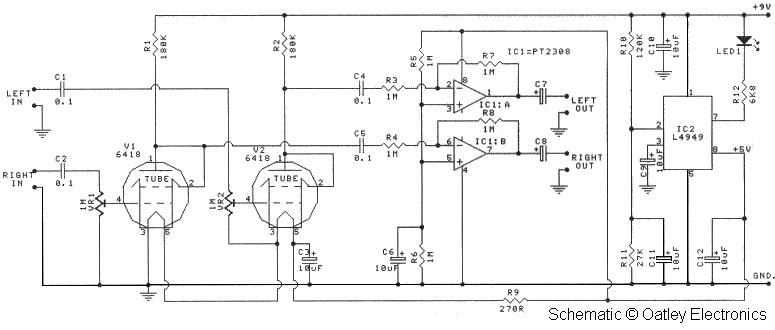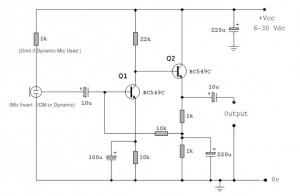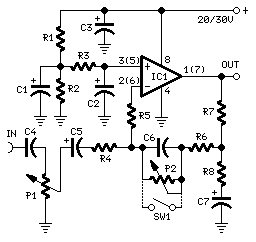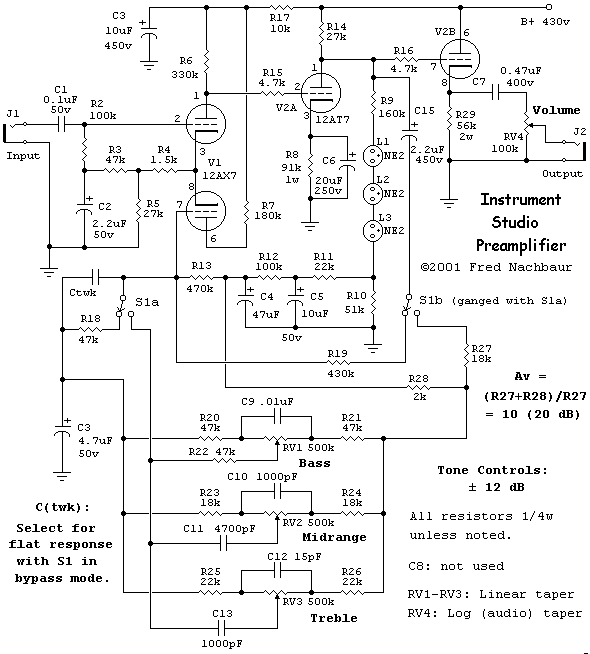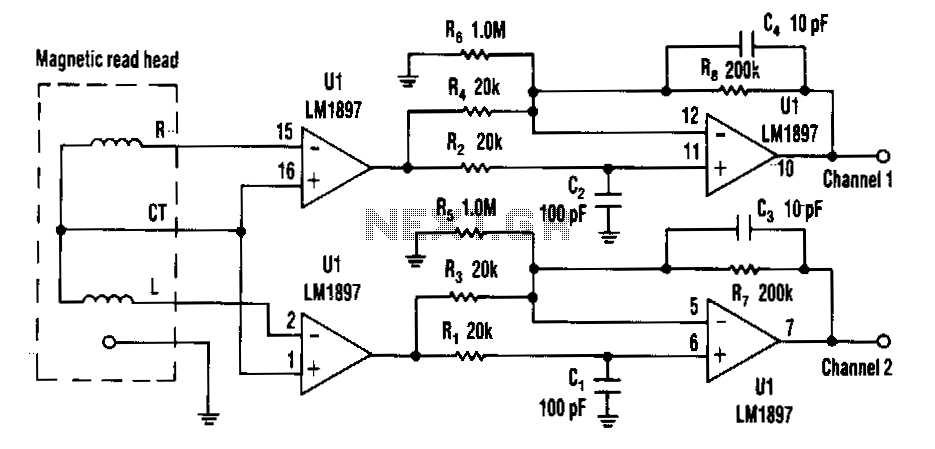
Line-level preamplifier
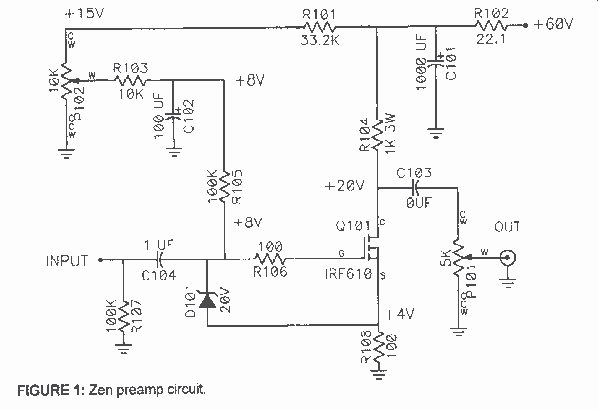
Since the volume control is after the gain stage, the preamp can be easily overloaded. I tried to limit the input signal by mounting a 470 k resistor in series with the CD input. A voltage divider is formed by this resistor and R107, resulting in a greater than 5-fold attenuation of signal input to the gain stage. Although the distortion had now disappeared, the resistors caused a severe limitation of the bandwidth of the preamp (-3 dB point about 15 kHz !). A lowpass filter was formed by the gate capacitance of the MOSfets in combination with the series resistors. More: Help came from an unexpected source. Mr. Colin Rutter, of Spectral Technologies PTY Ltd., Australia, sent me the following e-mail message: "The bad sound you experienced with the BOZ is due to the input signal being clipped asymmetrically as setting the bias current to 40 mA by measuring the voltage drop across the resistor may in fact not set the zero point correctly. A CRO (cathode ray oscilloscope) solves this problem or a bit of maths. My Bride of Zen has its idle current set at 32 mA for symmetrical clipping". Colin was completely right. Watching an amplified sine wave on an oscilloscope, I carefully lowered the bias of my BOZ. In my case, symmetric clipping occurred at a bias current of 28-29 mA. Finally, I removed all series resistors from the audio inputs. Clipping is no longer audible on CD, even during powerful crescendos. Although this is not shown in the schematic, Nelson suggests to include a mains filter in the power supply. I used a shielded filter (Schaffner FN2060-1-06, also marked 9540A, 1 A type) and mounted it between the mains switch and the power transformer. Before the filter was installed, there was a major transient upon turn-on and turn-off (loud thumping noise from the loudspeakers). After installation of the filter, there was no longer any transient. Thus, the filter is a major improvement. The preamp sound seems also to have improved (better resolution of low-level details, superior imaging). Unfortunately I could not find a dual concentric 5 k log stereo pot which would allow adjustment of both volume and channel balance; therefore I used a single mono potentiometer for each channel. I have used the BOZ now for several years, in combination with various poweramps (including, the Zen Revisited (Nelson Pass) and a Van Medevoort PA222. In all cases, the BOZ sounded very good. So this is a simple circuit of excellent quality, which can be easily built.
The circuit described is a preamplifier design known as the Bride of Zen (BOZ), which operates by amplifying audio signals for further processing or output to speakers. The design incorporates a volume control situated after the gain stage, which can lead to potential overload issues. To mitigate this, a 470 kΩ resistor is implemented in series with the CD input, forming a voltage divider with another resistor (R107). This configuration achieves over five-fold attenuation of the input signal before it reaches the gain stage, effectively eliminating distortion that would otherwise occur due to excessive input levels.
However, this approach introduces bandwidth limitations, with a -3 dB point around 15 kHz, primarily due to the lowpass filter characteristics formed by the gate capacitance of the MOSFETs in conjunction with the series resistors. The design also highlights the importance of proper biasing for optimal performance. Adjustments to the bias current, as suggested by an external source, reveal that a current of approximately 28-29 mA yields symmetric clipping, which is crucial for maintaining audio fidelity during dynamic passages.
In addition to the gain stage modifications, the inclusion of a mains filter (Schaffner FN2060-1-06) is recommended to suppress transients that could cause audible thumps during power cycling. This filter is installed between the mains switch and the power transformer, significantly improving the overall sound quality by reducing noise and enhancing detail resolution.
The preamp uses separate mono potentiometers for volume control in each channel, due to the unavailability of a dual concentric 5 kΩ logarithmic stereo potentiometer capable of adjusting both volume and balance simultaneously. The overall design emphasizes simplicity and high-quality audio reproduction, making it a suitable choice for various amplifier configurations, including those designed by Nelson Pass. The circuit's effectiveness has been validated through extensive use with multiple power amplifiers, demonstrating its reliability and performance in diverse audio setups.Since the volume control is after the gain stage, the preamp can be easily overloaded. I tried to limit the input signal by mounting a 470 k resistor in series with the CD input. A voltage divider is formed by this resistor and R107, resulting in a greater than 5-fold attenuation of signal input to the gain stage. Although the distortion had now disappeared, the resistors caused a severe limitation of the bandwidth of the preamp (-3 dB point about 15 kHz !).
A lowpass filter was formed by the gate capacitance of the MOSfets in combination with the series resistors. Help came from an unexpected source. Mr. Colin Rutter, of Spectral Technologies PTY Ltd., Australia, sent me the following e-mail message: "The bad sound you experienced with the BOZ is due to the input signal being clipped asymmetrically as setting the bias current to 40 mA by measuring the voltage drop across the resistor may in fact not set the zero point correctly. A CRO (cathode ray oscilloscope) solves this problem or a bit of maths. My Bride of Zen has its idle current set at 32 mA for symmetrical clipping". Colin was completely right. Watching an amplified sine wave on an oscilloscope, I carefully lowered the bias of my BOZ. In my case, symmetric clipping occurred at a bias current of 28-29 mA. Finally, I removed all series resistors from the audio inputs. Clipping is no longer audible on CD, even during powerful crescendos. Although this is not shown in the schematic, Nelson suggests to include a mains filter in the power supply.
I used a shielded filter (Schaffner FN2060-1-06, also marked 9540A, 1 A type) and mounted it between the mains switch and the power transformer. Before the filter was installed, there was a major transient upon turn-on and turn-off (loud thumping noise from the loudspeakers).
After installation of the filter, there was no longer any transient. Thus, the filter is a major improvement. The preamp sound seems also to have improved (better resolution of low-level details, superior imaging). Unfortunately I could not find a dual concentric 5 k log stereo pot which would allow adjustment of both volume and channel balance; therefore I used a single mono potentiometer for each channel.
I have used the BOZ now for several years, in combination with various poweramps (including, the Zen Revisited (Nelson Pass) and a Van Medevoort PA222. In all cases, the BOZ sounded very good. So this is a simple circuit of excellent quality, which can be easily built. 🔗 External reference
The circuit described is a preamplifier design known as the Bride of Zen (BOZ), which operates by amplifying audio signals for further processing or output to speakers. The design incorporates a volume control situated after the gain stage, which can lead to potential overload issues. To mitigate this, a 470 kΩ resistor is implemented in series with the CD input, forming a voltage divider with another resistor (R107). This configuration achieves over five-fold attenuation of the input signal before it reaches the gain stage, effectively eliminating distortion that would otherwise occur due to excessive input levels.
However, this approach introduces bandwidth limitations, with a -3 dB point around 15 kHz, primarily due to the lowpass filter characteristics formed by the gate capacitance of the MOSFETs in conjunction with the series resistors. The design also highlights the importance of proper biasing for optimal performance. Adjustments to the bias current, as suggested by an external source, reveal that a current of approximately 28-29 mA yields symmetric clipping, which is crucial for maintaining audio fidelity during dynamic passages.
In addition to the gain stage modifications, the inclusion of a mains filter (Schaffner FN2060-1-06) is recommended to suppress transients that could cause audible thumps during power cycling. This filter is installed between the mains switch and the power transformer, significantly improving the overall sound quality by reducing noise and enhancing detail resolution.
The preamp uses separate mono potentiometers for volume control in each channel, due to the unavailability of a dual concentric 5 kΩ logarithmic stereo potentiometer capable of adjusting both volume and balance simultaneously. The overall design emphasizes simplicity and high-quality audio reproduction, making it a suitable choice for various amplifier configurations, including those designed by Nelson Pass. The circuit's effectiveness has been validated through extensive use with multiple power amplifiers, demonstrating its reliability and performance in diverse audio setups.Since the volume control is after the gain stage, the preamp can be easily overloaded. I tried to limit the input signal by mounting a 470 k resistor in series with the CD input. A voltage divider is formed by this resistor and R107, resulting in a greater than 5-fold attenuation of signal input to the gain stage. Although the distortion had now disappeared, the resistors caused a severe limitation of the bandwidth of the preamp (-3 dB point about 15 kHz !).
A lowpass filter was formed by the gate capacitance of the MOSfets in combination with the series resistors. Help came from an unexpected source. Mr. Colin Rutter, of Spectral Technologies PTY Ltd., Australia, sent me the following e-mail message: "The bad sound you experienced with the BOZ is due to the input signal being clipped asymmetrically as setting the bias current to 40 mA by measuring the voltage drop across the resistor may in fact not set the zero point correctly. A CRO (cathode ray oscilloscope) solves this problem or a bit of maths. My Bride of Zen has its idle current set at 32 mA for symmetrical clipping". Colin was completely right. Watching an amplified sine wave on an oscilloscope, I carefully lowered the bias of my BOZ. In my case, symmetric clipping occurred at a bias current of 28-29 mA. Finally, I removed all series resistors from the audio inputs. Clipping is no longer audible on CD, even during powerful crescendos. Although this is not shown in the schematic, Nelson suggests to include a mains filter in the power supply.
I used a shielded filter (Schaffner FN2060-1-06, also marked 9540A, 1 A type) and mounted it between the mains switch and the power transformer. Before the filter was installed, there was a major transient upon turn-on and turn-off (loud thumping noise from the loudspeakers).
After installation of the filter, there was no longer any transient. Thus, the filter is a major improvement. The preamp sound seems also to have improved (better resolution of low-level details, superior imaging). Unfortunately I could not find a dual concentric 5 k log stereo pot which would allow adjustment of both volume and channel balance; therefore I used a single mono potentiometer for each channel.
I have used the BOZ now for several years, in combination with various poweramps (including, the Zen Revisited (Nelson Pass) and a Van Medevoort PA222. In all cases, the BOZ sounded very good. So this is a simple circuit of excellent quality, which can be easily built. 🔗 External reference
